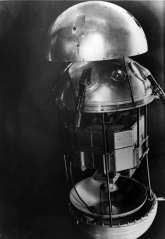
An exploded view of the Sputnik I spacecraft.
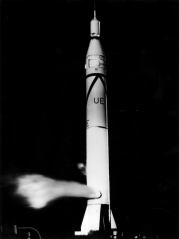
Explorer I sits on the launch pad venting before launch, January 31, 1958. (NASA photo 97-H-482)
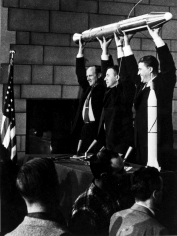
Dr. William H. Pickering, Dr. James A. Van Allen, and Dr. Wernher von Braun (left to right) hoist a model of Explorer I and the final stage after the successful launching on January 31, 1958. (NASA photo 78-H-136)
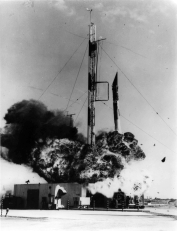
The first test launch of the Vanguard launch vehicle for the U.S.-IGY Earth Satellites Program to place a satellite in Earth orbit to determine atmospheric density and conduct geodetic measurements. A malfunction in the first stage caused the vehicle to lose thrust after two seconds, and the vehicle was destroyed.
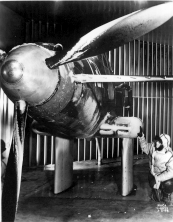
Icing research is under way during the 1940s at the Lewis Research Center in Cleveland, Ohio, one of the NACA's original facilities that became part of NASA.
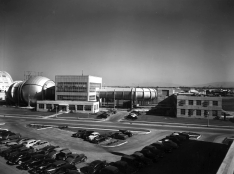
This photo shows the original twelve-foot pressure wind tunnel at the Ames Research Center in Mountain View, California, shortly after its construction in 1946. Ames was another NACA facility that became part of NASA. (NASA photo 94-H-418)
![]()
![]()
The Birth of NASA: November 3, 1957October 1, 1958
President Eisenhower spoke on television on November 7 as Sputnik I and Sputnik II orbited Earth. He displayed a missile nose cone recovered after a suborbital flight on a Jupiter-C rocket a few days before. Eisenhower's prepared statement focused on improving science and technology education, and he announced the appointment of Dr. James R. Killian, Jr., the president of the Massachusetts Institute of Technology, as his Special Assistant for Science and Technology. Killian's appointment was interpreted in Congress as a determination to put a civilian spin on the growing debate over the future course of U.S. space exploration.32 Eisenhower confirmed this conviction during a November 13 speech on technical education in Oklahoma City, in which he spoke publicly of a civilian space agency for the first time.
On Monday, November 25, the Senate Preparedness Subcommittee hearings commenced. These hearings kept Lyndon Johnson and the missile and space issues in the public eye for several weeks. Seventy-three witnesses provided their assessments of the state of U.S. missile technology and interpretations of the events leading up to Sputnik. John Hagen told Johnson that Project Vanguard could have beat Sputnik I into orbit if it had been afforded a higher priority.33 He reported that he had asked for higher priority in 1955 but never received a response.34
Donald Quarles testified that, in retrospect, the job of launching an IGY satellite should have been given to the Army in 1955. He hastened to add, however, that "[t]aking the missile program as a whole and comparing their [the Soviet] program with our own, I estimate that as of today our program is ahead." He told subcommittee chair Johnson that the United States was ahead in electronics, but it was hard to say which country was ahead in missiles. It was true, he said, that the Russians had a more powerful rocket engine, but "one would be even there cautious about the statement that they were ahead of us in rocket engines." He reported that since Sputnik I, there had been no acceleration of U.S. rocket programsnone was necessary. Johnson interpreted this as complacency on the part of the Pentagon and the Eisenhower White House. "The net of it is, "he drawled, "that the American people can have adequate defense and eat their cake tooand even have whipped cream on it."35
The subcommittee did not explore specifically how the United States should organize to explore space, but this complex and contentious issue was a subtext. As the hearings continued into early December, the Eisenhower administration transferred to the White House the Science Advisory Committee of the Defense Department's Office of Defense Mobilization. It became the nucleus of the new President's Science Advisory Committee (PSAC), which was constituted in part to consider how best to organize the U.S. space effort. Five new members were added, including James Doolittle, chair of the National Advisory Committee on Aeronautics (NACA), which was created in 1916 to be the civilian government organization performing research into aviation.
The push to organize a national space program received new impetus on December 6, when the Vanguard TV-3 rocket climbed about a yard above its Florida launch pad before falling back and exploding. The mission was to have been the first all-up test of the new Vanguard rocket. TV-3 carried a one- and-seven-tenths-kilogram (three-and-a-quarter-pound) test satellite derided by Soviet leader Khrushchev as an "orange."36
On December 30, James Killian wrote a memorandum to Eisenhower in which he noted that many scientists held "deeply felt convictions" opposing Defense Department control of the space program because they felt it would limit space research strictly to military objectives and would tar all U.S. space activity as military in nature. He then offered some organizational alternatives for space that he believed would provide "the means for non-military basic space research while at the same time taking advantage of the immense resources of the military missile and recon satellite programs." Killian proposed a Defense DepartmentÐoperated "central space laboratory with a very broad charter," which he likened to the Los Alamos National Laboratory. He wrote that the administration might also "encourage NACA to extend its space research and provide it with the necessary funds to do so."37, 38
The ABMA's Explorer satellite program continued in its backup role following the Vanguard TV-3's failure in December. Range restrictions prevented simultaneous Vanguard and Explorer launch preparations. The ABMA's opportunity arrived on January 26 when the backup to the ill-fated TV-3 vehicle, the Vanguard TV-3BU, had to "stand down" pending a second stage engine replacement. This gave the Huntsville team until about February 1 to make a launch attempt. The first attempt on January 30 was scrubbed because of unfavorable winds. The jet stream shifted north the next day, however. At 10:48 p.m. Eastern time on January 31, 1958, Explorer I lifted off on top of a Jupiter-C. At 12:51 a.m. on February 1, a successful orbit was confirmed.
Explorer I's success encouraged supporters of a crash effort to recoup lost U.S. prestige by launching an automated probe to the Moon. The proposal, first discussed in Barcelona the morning after Sputnik, came up for discussion in the February 4, 1958, Legislative Leadership Meeting at the White Housean opportunity for Republican congressional leaders and the Eisenhower administration to compare notes.
Interestingly, despite his problems with the Sputniks, Eisenhower remained cold to reaping the prestige benefits of a Moon shot. The meeting minutes state that Eisenhower was "firmly of the opinion that the rule of reason had to be applied to these Space projectsthat we couldn't pour unlimited funds into these costly projects where there was nothing of early value to the Nation's security. . . . [I]n the present situation, the President mused, he would rather have a good Redstone than be able to hit the moon, for we didn't have any enemies on the moon!" When Senator William Knowland pointed out the prestige value of being first to hit the Moon, Eisenhower relented partly, saying that if a rocket now available could do the job, work should go ahead. The President stressed, however, that he "didn't want to rush into an all-out effort on each of these possible glamor performances without a full appreciation of their great cost."39
Meanwhile, Congress discussed alternatives for organizing the U.S. space program. House Majority Leader John McCormack, a Massachusetts Democrat, called for a presidentially appointed National Science Council, while another faction sought to put the space program under control of the Atomic Energy Commission (AEC). Democratic Senators John McClellan of Arkansas and Hubert Humphrey of Minnesota called for the establishment of a Department of Science and Technology headed by a Cabinet-level secretary, a proposal Eisenhower opposed.40
Although making the NACA the nucleus of a civilian space program did not at first find supporters in Congress, it soon became the favorite option of the PSAC. On February 4, the Purcell Panel was established to consider organizational alternatives for space. The panel was named for Nobel Laureate Edward Purcell, who was appointed to the PSAC in December when it transferred to the White House. On February 21, S. Paul Johnston, director of the Institute for Aeronautical Sciences and a participant in the panel, summed up the issue of space program organization as one of "exploration" versus "control." The latter, he said, was a military function. He cited four possible organizational alternatives:
|
|
|
|
On February 6, the Senate formed an ad hoc Special Committee on Space and Astronautics chaired by Lyndon Johnson. On March 5, the same day Vanguard 1 reached orbit, the House of Representatives established the ad hoc Select Committee on Astronautics and Space Exploration with House Majority Leader John McCormack as chair. Also on March 5, the President's Advisory Committee on Government Organization chair Nelson Rockefeller, James Killian, and Bureau of the Budget Director Percival Brundage recommended to Eisenhower that "leadership of the civil space effort be lodged in a strengthened and redesignated National Advisory Committee for Astronautics."42 Eisenhower immediately authorized their proposal and assigned the Bureau of the Budget to draft the required legislation.
In a speech to a joint session of Congress on April 2, Eisenhower called for a NACA-based civilian National Aeronautics and Space Agency (NASA). He also handed down a directive ordering the NACA and the Defense Department to begin arranging the transfer of nonmilitary Department of Defense space assets to the NACA. On April 14, Lyndon Johnson and New Hampshire Republican Styles Bridges introduced the Senate version of the NASA bill (S-3609), and John McCormack introduced the House version (HR-11881). Hearings commenced the following day.
On May 1, James Van Allen announced that radiation detectors aboard Explorer I and Explorer III (launched March 26) had been swamped by high radiation levels at certain points in their orbits. This pointed to the existence of powerful radiation belts surrounding Earth. The detection of the Van Allen Belts was the first major space discovery. Supporters of Eisenhower's methodical approach to space exploration capitalized on the find, pointing out that the Soviet Union's two heavy Sputniks had accomplished no equivalent scientific feat. In fact, the Soviets had not launched a new satellite since Sputnik II in November.
On May 5, NACA chair James A. Doolittle testified to the House Committee on Astronautics and Space Exploration that the U.S. civilian space program had "two focused objectivesgaining scientific data using automated probes and sending into space craft that will carry men on voyages of exploration." Branding an early Moon shot a "stunt," Doolittle added that "[i]n our programming we should keep our eyes focused on these objectives. The fact that the Russians may accomplish some specific objectives in their space programs first should not in itself be permitted to divert us from our own designated objectives."43
Korolev's team had not stopped work since Sputnik II. On May 15, Korolev finally launched the conical, 1,330-kilogram (2,926-pound) Object-D satellite. Academician Sedov declared, "The new Sputnik . . . could easily carry a man with a stock of food and supplementary equipment."44 The sheer size of the satellite triggered new recriminations and new calls for action. Aviation Week editor-in-chief Robert Hotz again articulated well the mood in the U.S. space community:
| Successful launching of the 3000-lb Soviet Sputnik III should dispel most of the wishful thinking that has hung over the U.S. space policy since the fiery plunge of Sputnik II into the Caribbean [on April 14]. It proves once again that the Soviets' early Sputniks were no lucky accidents. It proves that the Soviet space program is a well-organized, consistent effort that is attempting to progress in significant increments rather than simply shooting for some spectacular, international propaganda stunt. It also indicates that the Soviet program has solid and consistent support not subject to the ups and downs of top level policy changes or political whims of the moment. . . . We are still debating in Congress the advisability of establishing a National Aeronautics and Space Agency. We hope Sputnik III will shake some of the Congressional nitpickers out of their lofty perches and prod them into action on this vital measure.45 |
Hotz soon got his wish. The House NASA bill passed on June 2, with the Senate version following on June 16. The most important conflict between the bills was the structure and composition of a committee advising the agency's director. The House billwhich Eisenhower favoredmade provision for a relatively weak seventeen-member advisory committee, while the Senate bill had a strong seven-member policy board. A bipartisan nineteen-member blue ribbon panel chaired by Johnson produced a joint version that retained the strong policy board. President Eisenhower continued his opposition to the policy board on the grounds that it would usurp presidential authority. Eisenhower and Johnson met at the White House on July 7 to break the impasse. Johnson suggested that the president serve as chair of the policy board, and Eisenhower agreed.46 The blue ribbon panel met for the final time on July 15, changing the policy board's name to the National Aeronautics and Space Council. Congress passed the final version of the bill on July 16, and President Eisenhower signed it into law on July 29, 1958.
The National Aeronautics and Space Act of 1958 (Public Law 85Ð568) stated that the NACA would become NASA after ninety days unless the transition was proclaimed sooner by the NASA administrator. On August 8, Eisenhower nominated T. Keith Glennan, the president of the Case Institute of Technology in Cleveland, Ohio, to be NASA's first administrator. He nominated NACA Director Hugh Dryden as deputy administrator. The Senate confirmed the nominations with little debate on August 14. On August 19, the Department of Defense and NASA agreed to transfer nonmilitary space projects, but they deferred the actual transfers until after NASA was in place. Glennan and Dryden were sworn in on August 20.
On August 17, the United States attempted its first Moon shot, an ARPA lunar orbiter on a Thor missile with an Able-1 upper stage. The Air Force Thor first stage exploded after seventy-seven seconds, destroying the thirty-eight-kilogram (eighty-four-pound) probe.
On September 4, Eisenhower appointed his fellow National Aeronautics and Space Council members. These included Glennan, Detlov Bronk, and James Doolittle. Glennan proclaimed NASA ready to succeed the NACA on September 25.
On October 1, 1958, NASA officially opened for business with five facilities inherited from the NACA: Lewis Research Center in Ohio, Langley Research Center and the Wallops rocket test range in Virginia, and Ames Research Center and the Muroc aircraft test range in California. That same day, Eisenhower issued an executive order transferring space projects and appropriations from other space programs to NASA. These gave NASA 8,240 staff (8,000 from the NACA) and a budget of approximately $340 million.